Hyundai Coupe 2002 Owner's Manual
Manufacturer: HYUNDAI, Model Year: 2002, Model line: Coupe, Model: Hyundai Coupe 2002Pages: 140, PDF Size: 1.45 MB
Page 111 of 140
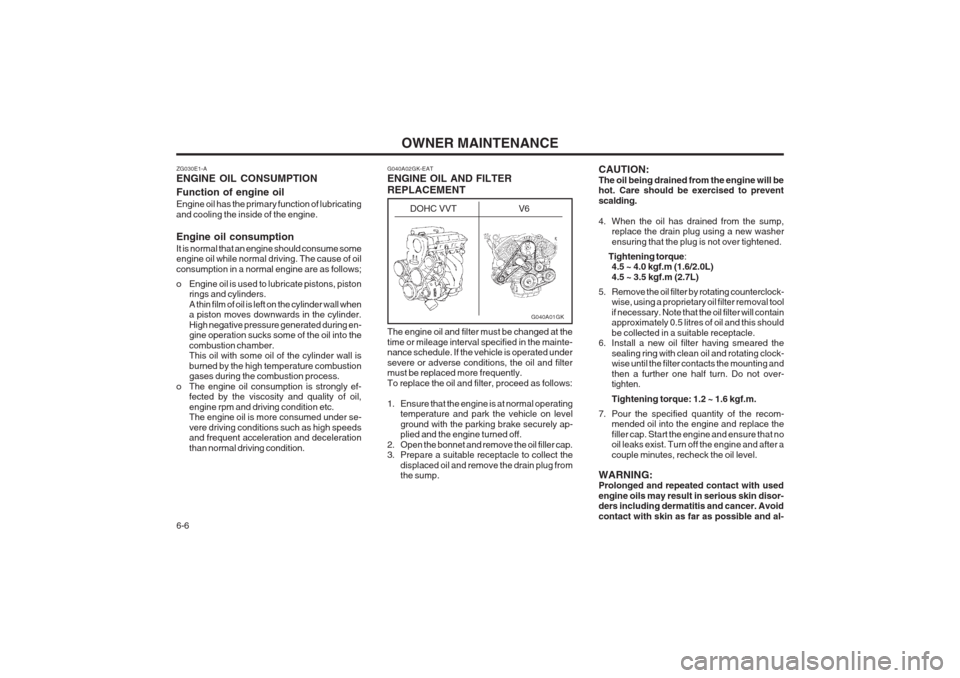
OWNER MAINTENANCE
6-6 CAUTION: The oil being drained from the engine will be hot. Care should be exercised to prevent scalding.
4. When the oil has drained from the sump,
replace the drain plug using a new washer ensuring that the plug is not over tightened.
Tightening torque :
4.5 ~ 4.0 kgf.m (1.6/2.0L)4.5 ~ 3.5 kgf.m (2.7L)
5. Remove the oil filter by rotating counterclock- wise, using a proprietary oil filter removal toolif necessary. Note that the oil filter will contain approximately 0.5 litres of oil and this should be collected in a suitable receptacle.
6. Install a new oil filter having smeared the
sealing ring with clean oil and rotating clock- wise until the filter contacts the mounting and then a further one half turn. Do not over- tighten. Tightening torque: 1.2 ~ 1.6 kgf.m.
7. Pour the specified quantity of the recom- mended oil into the engine and replace the filler cap. Start the engine and ensure that no oil leaks exist. Turn off the engine and after a couple minutes, recheck the oil level.
WARNING: Prolonged and repeated contact with used engine oils may result in serious skin disor- ders including dermatitis and cancer. Avoid contact with skin as far as possible and al-
G040A02GK-EAT ENGINE OIL AND FILTER REPLACEMENT The engine oil and filter must be changed at the time or mileage interval specified in the mainte- nance schedule. If the vehicle is operated under severe or adverse conditions, the oil and filter must be replaced more frequently. To replace the oil and filter, proceed as follows:
1. Ensure that the engine is at normal operating
temperature and park the vehicle on level ground with the parking brake securely ap- plied and the engine turned off.
2. Open the bonnet and remove the oil filler cap.
3. Prepare a suitable receptacle to collect the displaced oil and remove the drain plug fromthe sump.
ZG030E1-A ENGINE OIL CONSUMPTION Function of engine oil Engine oil has the primary function of lubricating and cooling the inside of the engine. Engine oil consumption It is normal that an engine should consume some engine oil while normal driving. The cause of oil consumption in a normal engine are as follows;
o Engine oil is used to lubricate pistons, piston
rings and cylinders. A thin film of oil is left on the cylinder wall when a piston moves downwards in the cylinder. High negative pressure generated during en- gine operation sucks some of the oil into the combustion chamber. This oil with some oil of the cylinder wall is burned by the high temperature combustion gases during the combustion process.
o The engine oil consumption is strongly ef- fected by the viscosity and quality of oil, engine rpm and driving condition etc. The engine oil is more consumed under se- vere driving conditions such as high speeds and frequent acceleration and deceleration than normal driving condition.
G040A01GK
DOHC VVT V6
Page 112 of 140
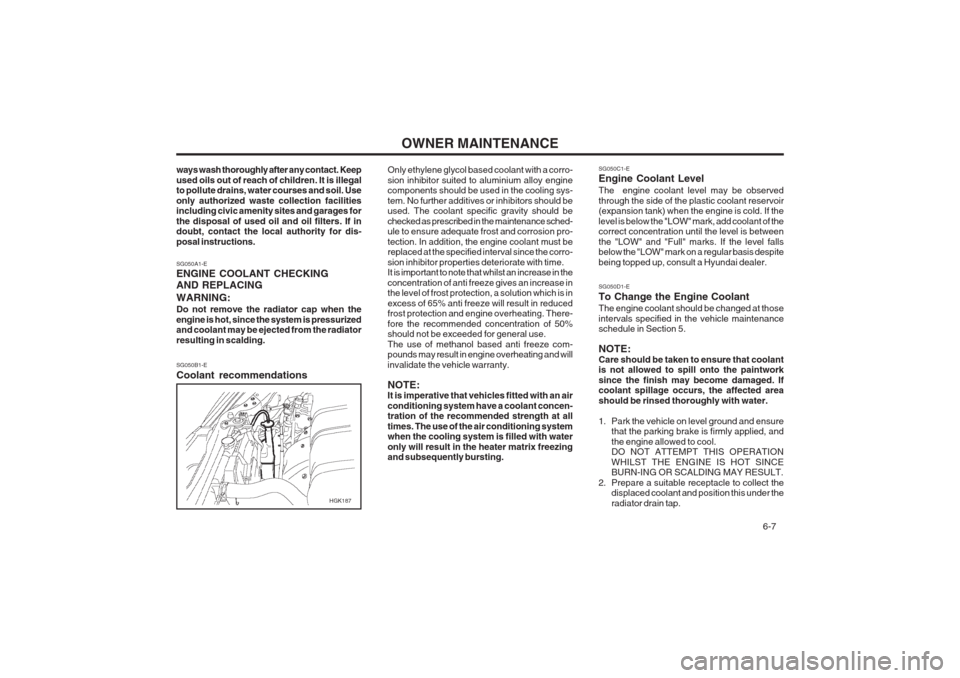
OWNER MAINTENANCE 6-7
ways wash thoroughly after any contact. Keep used oils out of reach of children. It is illegal to pollute drains, water courses and soil. Use only authorized waste collection facilities including civic amenity sites and garages for the disposal of used oil and oil filters. If in doubt, contact the local authority for dis- posal instructions. SG050A1-E ENGINE COOLANT CHECKING AND REPLACING WARNING: Do not remove the radiator cap when the engine is hot, since the system is pressurized and coolant may be ejected from the radiator resulting in scalding. SG050B1-E Coolant recommendations
Only ethylene glycol based coolant with a corro- sion inhibitor suited to aluminium alloy engine components should be used in the cooling sys- tem. No further additives or inhibitors should be used. The coolant specific gravity should be checked as prescribed in the maintenance sched- ule to ensure adequate frost and corrosion pro- tection. In addition, the engine coolant must be replaced at the specified interval since the corro- sion inhibitor properties deteriorate with time. It is important to note that whilst an increase in the concentration of anti freeze gives an increase in the level of frost protection, a solution which is in excess of 65% anti freeze will result in reduced frost protection and engine overheating. There- fore the recommended concentration of 50% should not be exceeded for general use. The use of methanol based anti freeze com- pounds may result in engine overheating and will invalidate the vehicle warranty. NOTE: It is imperative that vehicles fitted with an air conditioning system have a coolant concen- tration of the recommended strength at all times. The use of the air conditioning system when the cooling system is filled with water only will result in the heater matrix freezing and subsequently bursting.SG050C1-E Engine Coolant Level The engine coolant level may be observed through the side of the plastic coolant reservoir (expansion tank) when the engine is cold. If the level is below the "LOW" mark, add coolant of the correct concentration until the level is between the "LOW" and "Full" marks. If the level falls below the "LOW" mark on a regular basis despite being topped up, consult a Hyundai dealer. SG050D1-E To Change the Engine Coolant The engine coolant should be changed at those intervals specified in the vehicle maintenance schedule in Section 5. NOTE: Care should be taken to ensure that coolant is not allowed to spill onto the paintwork since the finish may become damaged. If coolant spillage occurs, the affected area should be rinsed thoroughly with water.
1. Park the vehicle on level ground and ensure
that the parking brake is firmly applied, and the engine allowed to cool. DO NOT ATTEMPT THIS OPERATION WHILST THE ENGINE IS HOT SINCE BURN-ING OR SCALDING MAY RESULT.
2. Prepare a suitable receptacle to collect the displaced coolant and position this under the radiator drain tap.
HGK187
Page 113 of 140
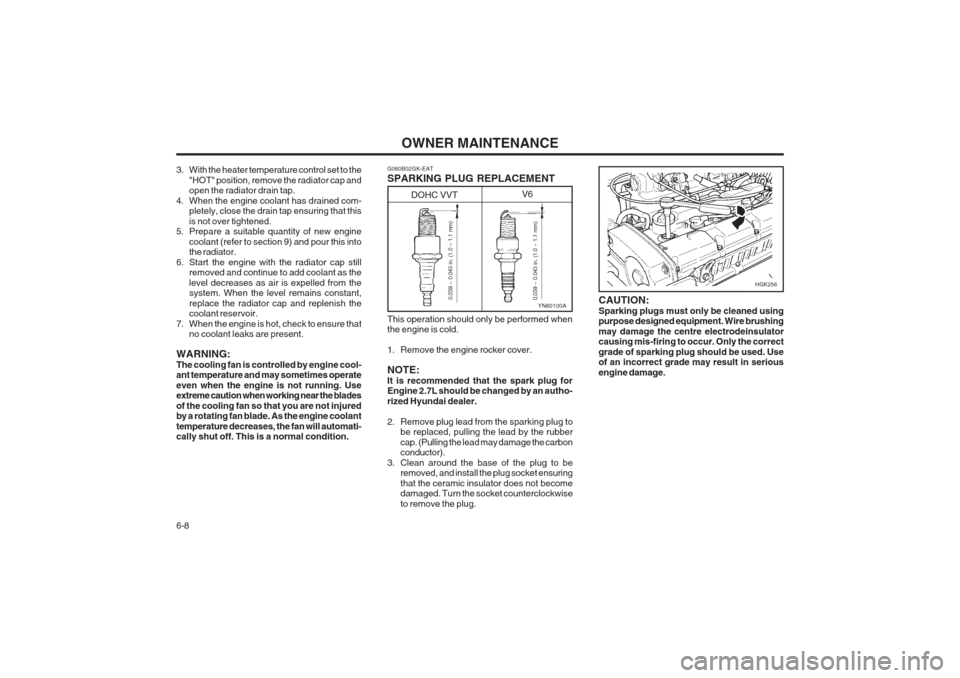
OWNER MAINTENANCE
6-8 CAUTION: Sparking plugs must only be cleaned using purpose designed equipment. Wire brushing may damage the centre electrodeinsulator causing mis-firing to occur. Only the correct grade of sparking plug should be used. Use of an incorrect grade may result in serious engine damage.
3. With the heater temperature control set to the
"HOT" position, remove the radiator cap and open the radiator drain tap.
4. When the engine coolant has drained com- pletely, close the drain tap ensuring that this is not over tightened.
5. Prepare a suitable quantity of new engine
coolant (refer to section 9) and pour this into the radiator.
6. Start the engine with the radiator cap still removed and continue to add coolant as the level decreases as air is expelled from the system. When the level remains constant, replace the radiator cap and replenish the coolant reservoir.
7. When the engine is hot, check to ensure that no coolant leaks are present.
WARNING: The cooling fan is controlled by engine cool- ant temperature and may sometimes operate even when the engine is not running. Use extreme caution when working near the blades of the cooling fan so that you are not injured by a rotating fan blade. As the engine coolant temperature decreases, the fan will automati- cally shut off. This is a normal condition. G060B02GK-EAT SPARKING PLUG REPLACEMENT This operation should only be performed when the engine is cold.
1. Remove the engine rocker cover.NOTE: It is recommended that the spark plug for Engine 2.7L should be changed by an autho- rized Hyundai dealer.
2. Remove plug lead from the sparking plug to
be replaced, pulling the lead by the rubber cap. (Pulling the lead may damage the carbon conductor).
3. Clean around the base of the plug to be removed, and install the plug socket ensuring that the ceramic insulator does not become damaged. Turn the socket counterclockwise to remove the plug.
YN60100A0.039 ~ 0.043 in. (1.0 ~ 1.1 mm)
0.039 ~ 0.043 in. (1.0 ~ 1.1 mm)
DOHC VVT V6
HGK256
Page 114 of 140
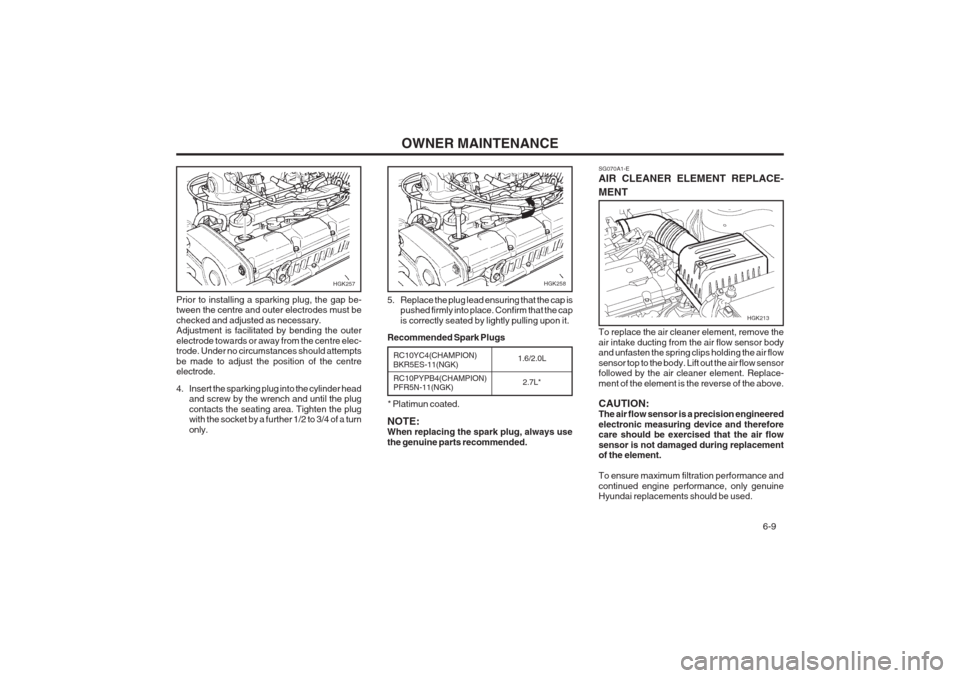
OWNER MAINTENANCE 6-9
SG070A1-E AIR CLEANER ELEMENT REPLACE- MENT
Prior to installing a sparking plug, the gap be- tween the centre and outer electrodes must be checked and adjusted as necessary. Adjustment is facilitated by bending the outer electrode towards or away from the centre elec- trode. Under no circumstances should attempts be made to adjust the position of the centre electrode.
4. Insert the sparking plug into the cylinder head and screw by the wrench and until the plug contacts the seating area. Tighten the plug with the socket by a further 1/2 to 3/4 of a turn only. 5. Replace the plug lead ensuring that the cap is
pushed firmly into place. Confirm that the capis correctly seated by lightly pulling upon it.
Recommended Spark Plugs To replace the air cleaner element, remove theair intake ducting from the air flow sensor body and unfasten the spring clips holding the air flow sensor top to the body. Lift out the air flow sensor followed by the air cleaner element. Replace- ment of the element is the reverse of the above. CAUTION: The air flow sensor is a precision engineered electronic measuring device and therefore care should be exercised that the air flow sensor is not damaged during replacement of the element. To ensure maximum filtration performance and continued engine performance, only genuine Hyundai replacements should be used.
NOTE:When replacing the spark plug, always use the genuine parts recommended.
RC10YC4(CHAMPION) BKR5ES-11(NGK) RC10PYPB4(CHAMPION) PFR5N-11(NGK)1.6/2.0L
2.7L*
* Platimun coated.
HGK213
HGK258HGK257
Page 115 of 140
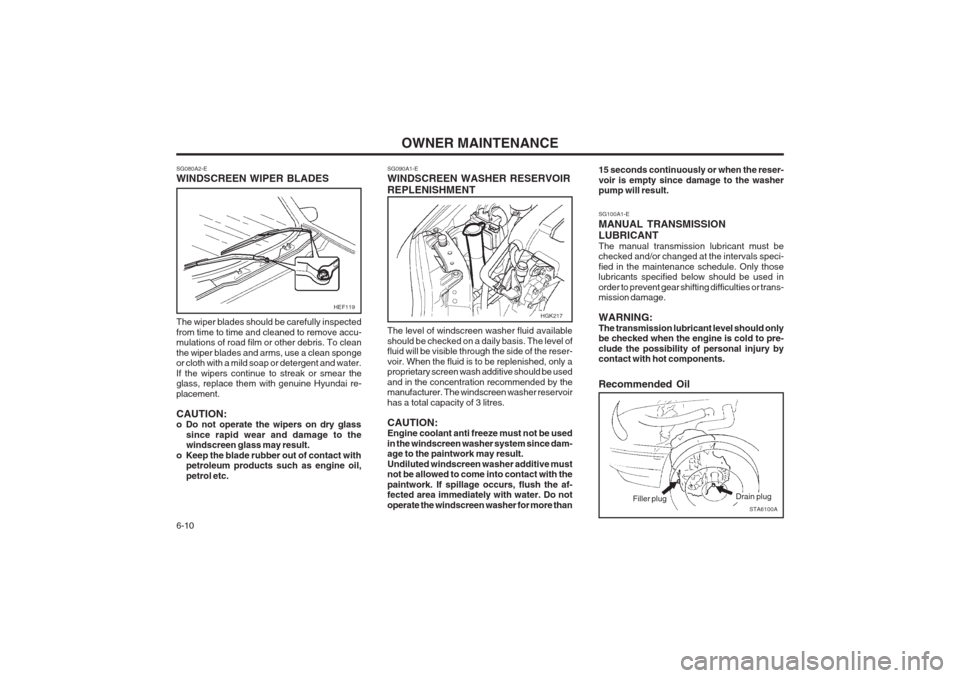
OWNER MAINTENANCE
6-10 15 seconds continuously or when the reser- voir is empty since damage to the washer pump will result. SG100A1-E MANUAL TRANSMISSION LUBRICANT The manual transmission lubricant must be checked and/or changed at the intervals speci- fied in the maintenance schedule. Only those lubricants specified below should be used in order to prevent gear shifting difficulties or trans- mission damage. WARNING: The transmission lubricant level should only be checked when the engine is cold to pre- clude the possibility of personal injury by contact with hot components.
Filler plugDrain plug
STA6100A
Recommended Oil
SG080A2-E WINDSCREEN WIPER BLADES
SG090A1-EWINDSCREEN WASHER RESERVOIR REPLENISHMENT
The wiper blades should be carefully inspected from time to time and cleaned to remove accu- mulations of road film or other debris. To clean the wiper blades and arms, use a clean sponge or cloth with a mild soap or detergent and water. If the wipers continue to streak or smear the glass, replace them with genuine Hyundai re- placement. CAUTION:
o Do not operate the wipers on dry glass since rapid wear and damage to thewindscreen glass may result.
o Keep the blade rubber out of contact with petroleum products such as engine oil, petrol etc. The level of windscreen washer fluid availableshould be checked on a daily basis. The level of fluid will be visible through the side of the reser- voir. When the fluid is to be replenished, only a proprietary screen wash additive should be used and in the concentration recommended by the manufacturer. The windscreen washer reservoir has a total capacity of 3 litres. CAUTION: Engine coolant anti freeze must not be used in the windscreen washer system since dam- age to the paintwork may result. Undiluted windscreen washer additive must not be allowed to come into contact with the paintwork. If spillage occurs, flush the af- fected area immediately with water. Do not operate the windscreen washer for more than
HGK217HEF119
Page 116 of 140
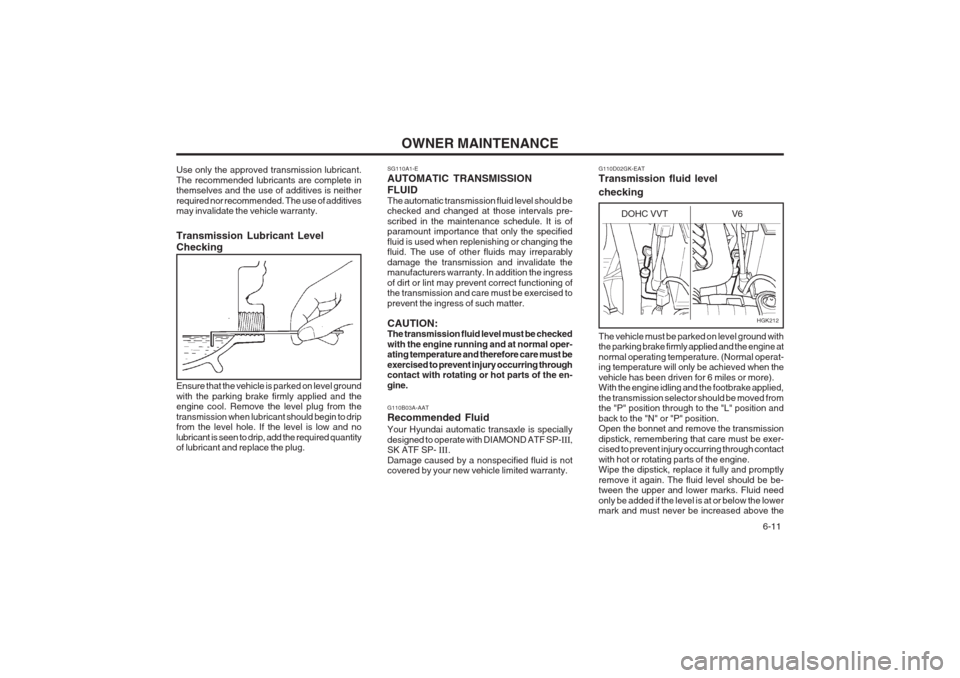
OWNER MAINTENANCE 6-11
Use only the approved transmission lubricant. The recommended lubricants are complete in themselves and the use of additives is neither required nor recommended. The use of additives may invalidate the vehicle warranty. Transmission Lubricant Level Checking
Ensure that the vehicle is parked on level ground with the parking brake firmly applied and the engine cool. Remove the level plug from the transmission when lubricant should begin to drip from the level hole. If the level is low and no lubricant is seen to drip, add the required quantity of lubricant and replace the plug.
SG110A1-E AUTOMATIC TRANSMISSION FLUID The automatic transmission fluid level should be checked and changed at those intervals pre- scribed in the maintenance schedule. It is of paramount importance that only the specified fluid is used when replenishing or changing the fluid. The use of other fluids may irreparably damage the transmission and invalidate the manufacturers warranty. In addition the ingress of dirt or lint may prevent correct functioning of the transmission and care must be exercised to prevent the ingress of such matter. CAUTION: The transmission fluid level must be checked with the engine running and at normal oper- ating temperature and therefore care must be exercised to prevent injury occurring through contact with rotating or hot parts of the en- gine. G110B03A-AAT Recommended Fluid Your Hyundai automatic transaxle is specially designed to operate with DIAMOND ATF SP-
III,
SK ATF SP- III.
Damage caused by a nonspecified fluid is not covered by your new vehicle limited warranty. G110D02GK-EAT Transmission fluid level checking The vehicle must be parked on level ground with the parking brake firmly applied and the engine at normal operating temperature. (Normal operat- ing temperature will only be achieved when the vehicle has been driven for 6 miles or more). With the engine idling and the footbrake applied, the transmission selector should be moved from the "P" position through to the "L" position and back to the "N" or "P" position. Open the bonnet and remove the transmission dipstick, remembering that care must be exer- cised to prevent injury occurring through contact with hot or rotating parts of the engine. Wipe the dipstick, replace it fully and promptly remove it again. The fluid level should be be- tween the upper and lower marks. Fluid need only be added if the level is at or below the lower mark and must never be increased above the
DOHC VVT V6
HGK212
Page 117 of 140
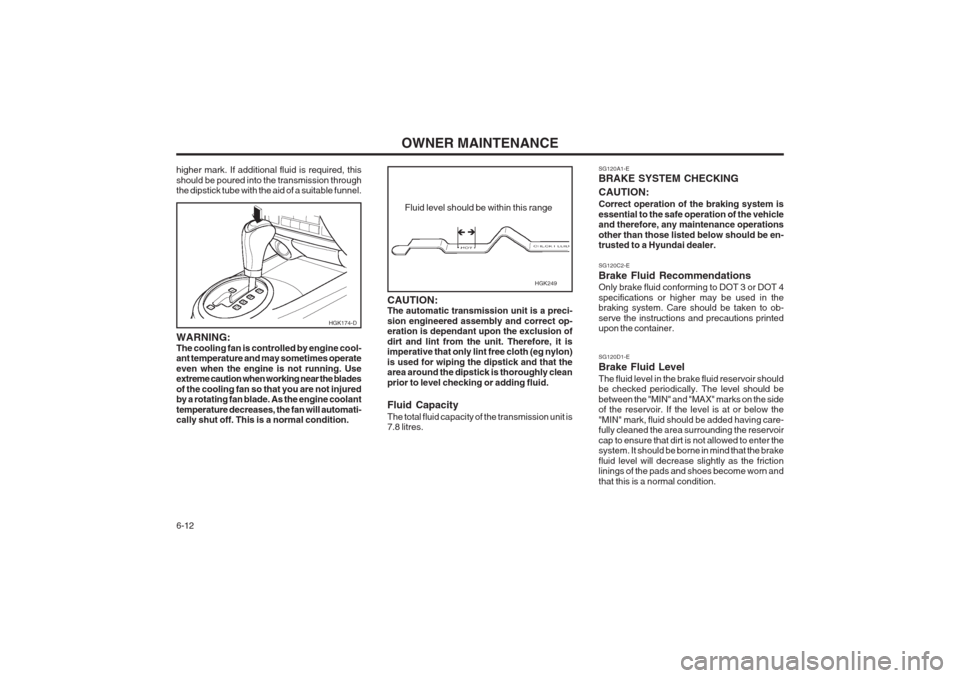
OWNER MAINTENANCE
6-12 SG120A1-E BRAKE SYSTEM CHECKING CAUTION: Correct operation of the braking system is essential to the safe operation of the vehicle and therefore, any maintenance operations other than those listed below should be en- trusted to a Hyundai dealer. SG120C2-E Brake Fluid Recommendations Only brake fluid conforming to DOT 3 or DOT 4 specifications or higher may be used in the braking system. Care should be taken to ob- serve the instructions and precautions printed upon the container. SG120D1-E Brake Fluid LevelThe fluid level in the brake fluid reservoir should be checked periodically. The level should be between the "MIN" and "MAX" marks on the side of the reservoir. If the level is at or below the "MIN" mark, fluid should be added having care- fully cleaned the area surrounding the reservoir cap to ensure that dirt is not allowed to enter the system. It should be borne in mind that the brake fluid level will decrease slightly as the friction linings of the pads and shoes become worn and that this is a normal condition.
higher mark. If additional fluid is required, thisshould be poured into the transmission through the dipstick tube with the aid of a suitable funnel. WARNING: The cooling fan is controlled by engine cool- ant temperature and may sometimes operate even when the engine is not running. Use extreme caution when working near the blades of the cooling fan so that you are not injured by a rotating fan blade. As the engine coolant temperature decreases, the fan will automati- cally shut off. This is a normal condition.
CAUTION:The automatic transmission unit is a preci- sion engineered assembly and correct op- eration is dependant upon the exclusion of dirt and lint from the unit. Therefore, it is imperative that only lint free cloth (eg nylon) is used for wiping the dipstick and that the area around the dipstick is thoroughly clean prior to level checking or adding fluid. Fluid Capacity The total fluid capacity of the transmission unit is 7.8 litres.
HGK174-D
Fluid level should be within this range
HGK249
�Î�Î
Page 118 of 140
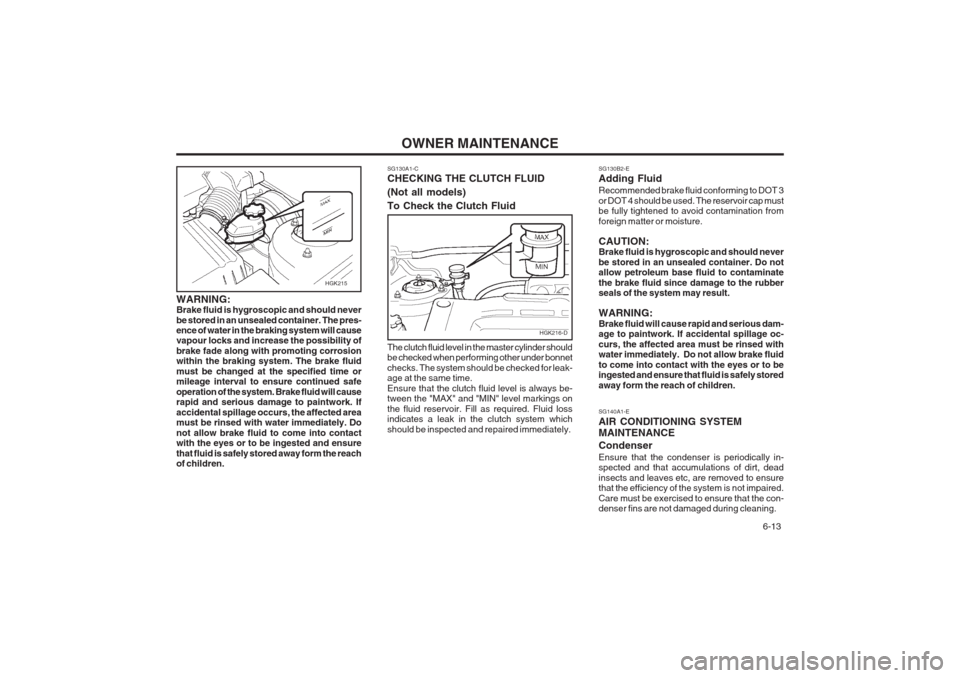
OWNER MAINTENANCE 6-13
WARNING: Brake fluid is hygroscopic and should never be stored in an unsealed container. The pres- ence of water in the braking system will causevapour locks and increase the possibility of brake fade along with promoting corrosion within the braking system. The brake fluid must be changed at the specified time or mileage interval to ensure continued safe operation of the system. Brake fluid will cause rapid and serious damage to paintwork. If accidental spillage occurs, the affected area must be rinsed with water immediately. Do not allow brake fluid to come into contact with the eyes or to be ingested and ensure that fluid is safely stored away form the reach of children. SG130A1-C CHECKING THE CLUTCH FLUID (Not all models)To Check the Clutch Fluid The clutch fluid level in the master cylinder should be checked when performing other under bonnet checks. The system should be checked for leak- age at the same time. Ensure that the clutch fluid level is always be- tween the "MAX" and "MIN" level markings on the fluid reservoir. Fill as required. Fluid loss indicates a leak in the clutch system which should be inspected and repaired immediately.
SG130B2-E Adding Fluid Recommended brake fluid conforming to DOT 3 or DOT 4 should be used. The reservoir cap must be fully tightened to avoid contamination from foreign matter or moisture. CAUTION: Brake fluid is hygroscopic and should never be stored in an unsealed container. Do not allow petroleum base fluid to contaminate the brake fluid since damage to the rubber seals of the system may result. WARNING: Brake fluid will cause rapid and serious dam- age to paintwork. If accidental spillage oc- curs, the affected area must be rinsed with water immediately. Do not allow brake fluid to come into contact with the eyes or to be ingested and ensure that fluid is safely stored away form the reach of children. SG140A1-E AIR CONDITIONING SYSTEM MAINTENANCE Condenser Ensure that the condenser is periodically in- spected and that accumulations of dirt, dead insects and leaves etc, are removed to ensure that the efficiency of the system is not impaired. Care must be exercised to ensure that the con- denser fins are not damaged during cleaning.
HGK215
HGK216-D
Page 119 of 140
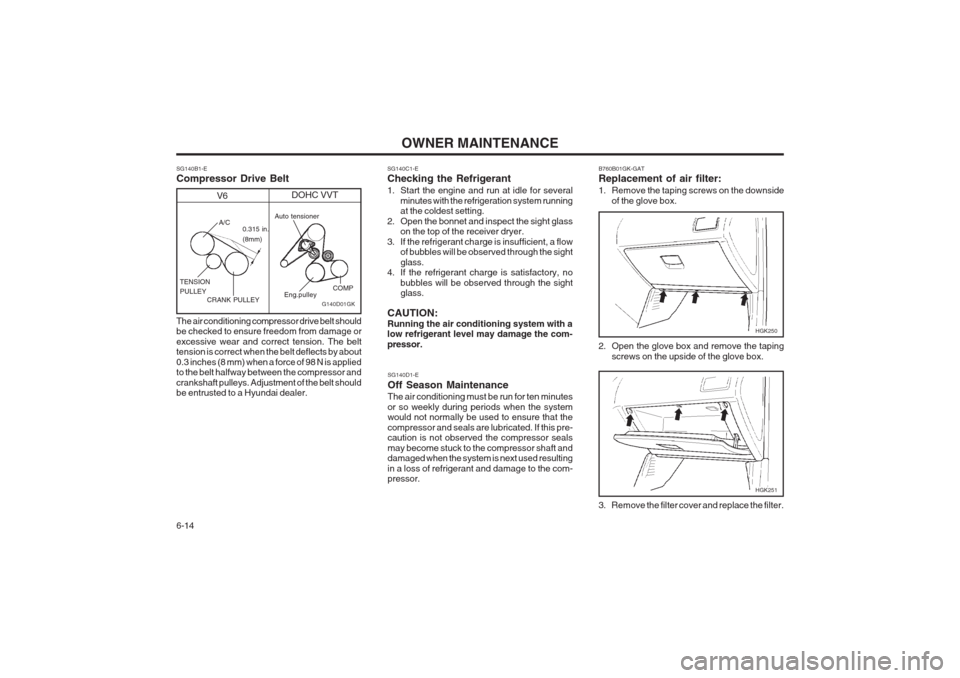
OWNER MAINTENANCE
6-14
SG140B1-E Compressor Drive Belt The air conditioning compressor drive belt should be checked to ensure freedom from damage or excessive wear and correct tension. The belt tension is correct when the belt deflects by about 0.3 inches (8 mm) when a force of 98 N is applied to the belt halfway between the compressor and crankshaft pulleys. Adjustment of the belt should be entrusted to a Hyundai dealer.
SG140C1-E Checking the Refrigerant
1. Start the engine and run at idle for several
minutes with the refrigeration system running at the coldest setting.
2. Open the bonnet and inspect the sight glass on the top of the receiver dryer.
3. If the refrigerant charge is insufficient, a flow of bubbles will be observed through the sight glass.
4. If the refrigerant charge is satisfactory, no
bubbles will be observed through the sight glass.
CAUTION: Running the air conditioning system with a low refrigerant level may damage the com- pressor.
A/C
CRANK PULLEY
TENSION PULLEY 0.315 in. (8mm)
G140D01GK
V6
DOHC VVT
Auto tensioner
Eng.pulleyCOMP
SG140D1-E Off Season Maintenance The air conditioning must be run for ten minutes or so weekly during periods when the system would not normally be used to ensure that the compressor and seals are lubricated. If this pre- caution is not observed the compressor seals may become stuck to the compressor shaft and damaged when the system is next used resulting in a loss of refrigerant and damage to the com- pressor. B760B01GK-GAT Replacement of air filter:
1. Remove the taping screws on the downside
of the glove box.
HGK250
HGK251
2. Open the glove box and remove the taping
screws on the upside of the glove box.
3. Remove the filter cover and replace the filter.
Page 120 of 140
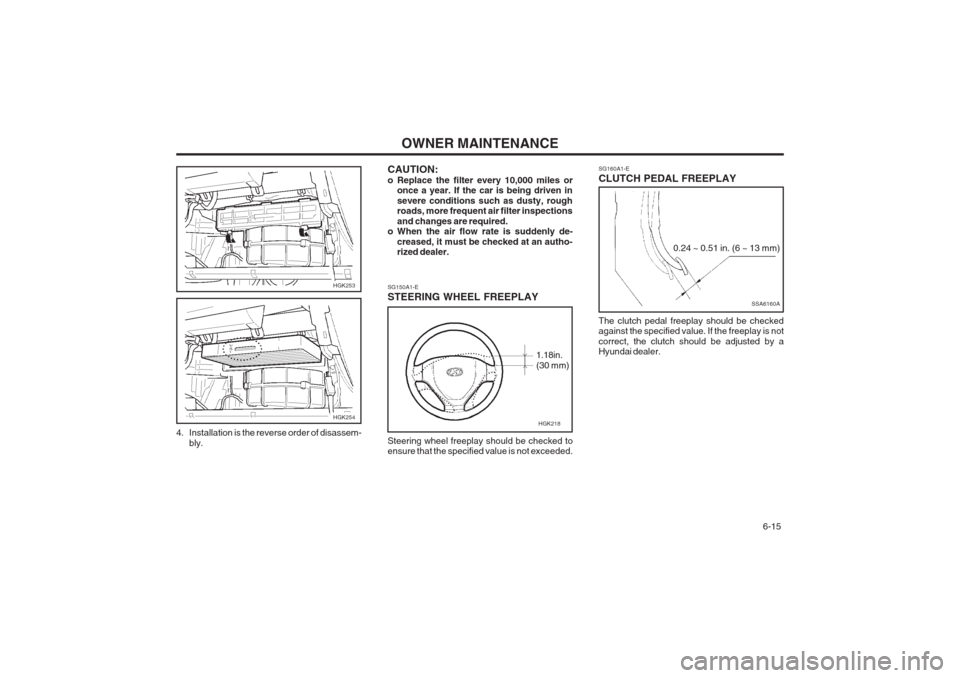
OWNER MAINTENANCE 6-15
HGK253
HGK254
4. Installation is the reverse order of disassem- bly. CAUTION:
o Replace the filter every 10,000 miles or
once a year. If the car is being driven insevere conditions such as dusty, rough roads, more frequent air filter inspections and changes are required.
o When the air flow rate is suddenly de-
creased, it must be checked at an autho- rized dealer.
SG150A1-E STEERING WHEEL FREEPLAY Steering wheel freeplay should be checked to ensure that the specified value is not exceeded.HGK218
SG160A1-E CLUTCH PEDAL FREEPLAY
SSA6160A
0.24 ~ 0.51 in. (6 ~ 13 mm)
The clutch pedal freeplay should be checked against the specified value. If the freeplay is not correct, the clutch should be adjusted by a Hyundai dealer.
1.18in. (30 mm)